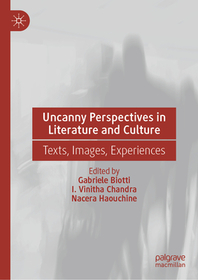
Uncanny Perspectives in Literature and Culture
Texts, Images, Experiences
- Publisher's listprice EUR 160.49
-
66 563 Ft (63 393 Ft + 5% VAT)
The price is estimated because at the time of ordering we do not know what conversion rates will apply to HUF / product currency when the book arrives. In case HUF is weaker, the price increases slightly, in case HUF is stronger, the price goes lower slightly.
- Discount 20% (cc. 13 313 Ft off)
- Discounted price 53 250 Ft (50 714 Ft + 5% VAT)
Subcribe now and take benefit of a favourable price.
Subscribe
66 563 Ft

Availability
printed on demand
Why don't you give exact delivery time?
Delivery time is estimated on our previous experiences. We give estimations only, because we order from outside Hungary, and the delivery time mainly depends on how quickly the publisher supplies the book. Faster or slower deliveries both happen, but we do our best to supply as quickly as possible.
Product details:
- Edition number 2024
- Publisher Springer Nature Switzerland
- Date of Publication 1 October 2024
- Number of Volumes 1 pieces, Book
- ISBN 9783031671647
- Binding Hardback
- No. of pages336 pages
- Size 210x148 mm
- Language English
- Illustrations XVII, 336 p. 8 illus., 1 illus. in color. Illustrations, black & white 600
Categories
Long description:
This collection of essays aims to analyse the uncanny as a concept developed in the field of the arts, from a variety of perspectives axed in the literary field, in the media context, and in film studies, with references to contemporary thought. The book aims to provide readers with a methodological updating on this psychoanalytic concept, starting from its basic rethinking, under the light of the different cultural backgrounds of the authors whose essays are collected.
The book’s specific focus is in the research on the many faces the uncanny took in different experiences, forms of writing, ideas of art, theories, discourses, and experiences in creation. This shows, still today, not only the concept’s richness in defining our contemporary cultural context, but also its plasticity and its identity of notion-hinge between eras, ideas of representation, and forms of writing of various types.
MoreTable of Contents:
Part I: Post Humanism.- Chapter 1: Murderbot and the Uncanny: The Familiar Unfamiliarity of Non-Human Humanity by Kellyn Stinnett.- Chapter 2: “Machines like us”: an overview of A.I. and human nature by Tiziana Lentini.- Part II: Uncanny Bodies and the Human.- Chapter 3: Looking at Iconography of Ophelia to Understand the Uncanny in the Beautiful Dead Girl Trope by Danielle Byington.- Chapter 4: Yoko Tawada’s “The Emissary”: An Aesthetic Leap Towards a Queer and Uncanny Ecology by Valentina Rosales.- Chapter 5: Documenting pain through love. “Tomoko and Mother in the Bath by Carlotta Berti.- Chapter 6: Dostoevsky’s ‘Uncanny’ Disease by Byron Byrne Taylor.- Part III: Visual Culture.- Chapter 7: “Blindspot” and “Avengers Infinity War” Translating Uncanny Geographies in Television and Film: Repetition, Doubling, and The Twin Towers by Loraine Haywood.- Chapter 8: Uncanny synaesthesia(s): the interplay between forms, sounds, and colours in Samuel Beckett’s “Play” and Wassily Kandinsky’s “In Grey by Abdellatif Ben Halima.- Chapter 09: Thin Places, Other Worlds and Visual Layering in Cinema by Chris Gerrard.- Chapter 10: Fluidity in Stillness: Jean Epstein’s Uncanny ‘Photogénie’ and the Found Footage Film by Anna Louise Wiegenstein.- Chapter 11: Uncanny Objects: Lacan, Heidegger, and Return of the Gaze by Matilda Cullen and Cameron More.- Part IV: Spatiality.- Chapter 12: The Contemporary Uncanny after Brexit: Literary Disruptions of the Self by Mandy Beck.- Chapter 13: The Uncanny, Unsurmountable Beliefs and Postrevolutionary Mexico in Juan Bustillo Oro’s Dos monjes by Kevin Anzzolin.- Part V: The ‘Uncanny’ Trope.- Chapter 14: Portrait of the Uncanny in Haruki Murakami’s Killing Commendatore by Jamie Johnson.- Chapter 15: Haruki Murakami’s use of the Uncanny in “After Dark” (2004): the corruption of the home space and the subjugation of the female characters by Gemma Scammell.- Part VI: The Self and the Other: Uncanny Limits.- Chapter 16: Love, Death and Femme Fatales in Keats’ Works by Federica Montella.- Chapter 17: The Mimic and the Uncanny: Reading Waste in “English, August” by Sonakshi Srivastava.
More



